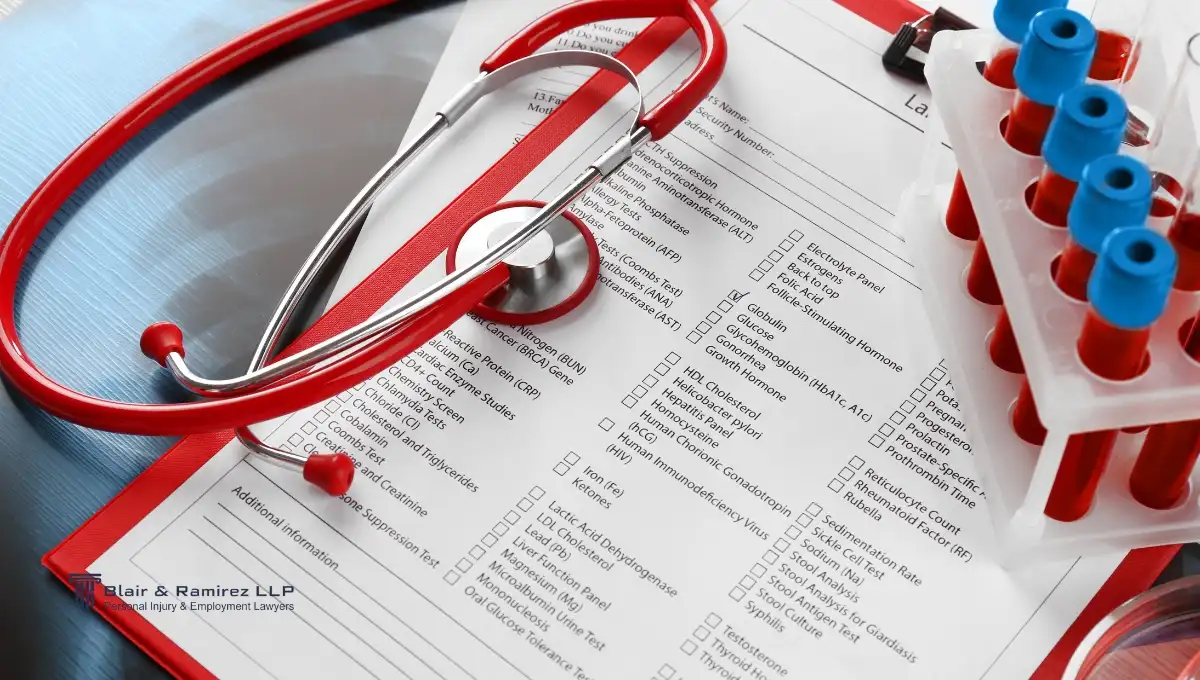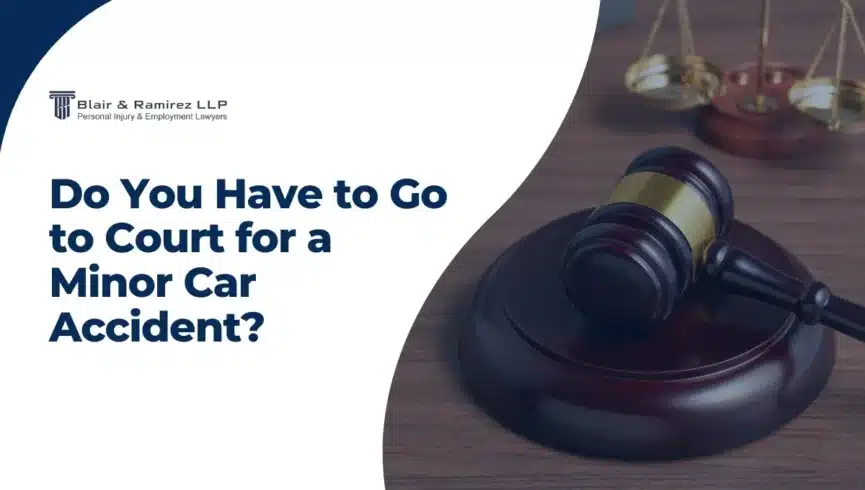After a minor car accident in California, many drivers worry that they will be forced into court. The truth is that you generally do not have to go to court for a minor auto collision. Most cases are resolved through insurance claims and negotiation, meaning you can recover compensation without filing a lawsuit.
Still, there are exceptions. If the at-fault driver’s policy limits are too low, if insurers dispute liability, or if hidden injuries appear after the crash, your case could escalate. In those rare situations, you can sue someone for a car accident, but even then, trials remain uncommon.
Knowing that most auto accident claims settle out of court provides peace of mind, but knowing when a case must go to court is key to avoiding unnecessary legal battles. With the right legal guidance, you can protect your rights and avoid unnecessary legal battles.
When Does a Minor Car Accident Go to Court in California?
Most minor accidents in California are resolved through insurance claims, but not all disputes end quietly. Court becomes necessary when settlement talks break down, whether because liability is contested, coverage falls short, or injuries are more serious than they first appeared. While less than five percent of cases ever go to trial, those that do often share the same set of triggers.
During a Fault Dispute Between Drivers or Insurers
If the At-Fault Driver Is Uninsured or Underinsured
Another frequent cause of litigation is when the at-fault driver carries no insurance or too little to cover your losses. California law requires $15,000 per person and $30,000 per accident for injuries, plus $5,000 for property damage, but many drivers fall below this standard. If your own uninsured/underinsured motorist coverage is disputed or delayed, you may need to sue directly or pursue arbitration that can ultimately lead to court if unresolved.
When Minor Injuries Become Major Over Time
What seems like a small ache at the scene can turn into a major medical issue days later. Whiplash, concussions, and soft-tissue injuries often require ongoing care that insurers try to write off as unrelated. When that happens, filing suit supported by medical records and expert testimony may be the only way to prove causation and recover the cost of long-term treatment.
When Property Damage or Medical Costs Exceed Coverage
Even low-speed collisions can create expenses that overwhelm California’s minimum coverage. Replacing airbags, repairing frame damage, or paying for an ER visit can exceed policy limits in a single claim. Once the insurer pays the maximum allowed, the only option left is to sue the at-fault driver in small claims court for lower amounts or in civil court for larger losses.
If a Police Report Is Missing or Contested
When a police report is absent or inaccurate, insurers often exploit the gap to question fault. In that situation, litigation lets you introduce other evidence, such as black box data, CCTV footage, or eyewitness statements, to establish liability on firmer ground. The court ensures these competing accounts are evaluated under legal standards rather than left to the insurer’s discretion.

How Do Insurance Companies Handle Minor Car Accidents in California?
Insurance companies usually settle minor accidents without going to court, but the process is designed to protect their bottom line, not yours. Claims often follow the same pattern:
- Initial Evaluation: Adjusters review police reports, photos, repair estimates, and medical records to assign a claim value. Because their job is to minimize payouts, the number is often lower than your real costs.
- Delays and Denials: Even in straightforward cases, insurers may drag out the process. They request duplicate documents, dispute the need for treatment, or stall communication. In California, these tactics can cross into bad faith, but until challenged, they succeed in pressuring victims to accept less.
- Low Settlement Offers: Once an offer comes, it is usually based on the insurer’s low evaluation. Minor crashes are often labeled “low-impact,” and quick cash offers are made before long-term expenses like therapy or lost wages are clear. These offers close claims cheaply while leaving drivers responsible for future costs.
For many drivers, the claims process feels less like a fair negotiation and more like a strategy to limit recovery. Recognizing these tactics early makes it easier to protect your rights and push back against undervalued settlements.
What Happens If the Other Driver Has No Insurance?
Accidents grow more complicated when the at-fault driver has no coverage, a situation common in uninsured driver accidents in California. While state law requires minimum liability coverage, many drivers let policies lapse. Your recovery may then depend on uninsured motorist coverage, arbitration, or direct litigation.
Your recovery usually depends on three possible paths:
- Uninsured Motorist Laws
- California Insurance Code §11580.2 requires insurers to offer uninsured/underinsured motorist (UM/UIM) coverage.
- Unless you declined it in writing, your policy likely includes it.
- This protection acts as a backup when the at-fault driver has no coverage or too little to pay for your losses.
- Using UM/UIM Coverage
- When you file a UM/UIM claim, your insurer steps in as if it were the at-fault driver’s company.
- Covered damages may include medical expenses, lost wages, and property damage up to your policy limits.
- Most UM/UIM disputes go through arbitration, but if the insurer delays, undervalues, or denies payment, litigation may be necessary.
- Legal Action Beyond Insurance
- If you don’t have UM/UIM coverage, or if your losses exceed the available limits, you can sue the at-fault driver directly.
- Collecting damages is difficult since uninsured drivers often lack assets, but it may be necessary in serious injury cases.
- You can also sue your own insurer for bad faith if it refuses to pay a valid UM/UIM claim.
Can Delayed Injuries Lead to Court Cases?
Yes. Delayed injuries after a minor car accident often lead to court because insurers dispute their connection to the crash. Victims may feel fine initially, only to develop symptoms days or weeks later. When insurers dismiss these conditions as unrelated, lawsuits backed by medical evidence become the only way to secure fair compensation.
Common Latent Injuries: Whiplash, Concussions, Soft-Tissue Damage
Some injuries don’t show up at the scene but emerge gradually. These hidden conditions can turn a “minor” crash into a long-term medical and legal battle:
| Injury Type | Typical Onset | Common Symptoms |
|---|---|---|
| Whiplash | 24–72 hours | Neck pain, stiffness, headaches, reduced motion |
| Concussion | Hours to days | Headaches, dizziness, confusion, nausea, memory loss |
| Soft-Tissue Damage | Several days | Swelling, muscle strain, back or shoulder pain |
Insurers frequently label these injuries as minor or unrelated, making it critical to present strong medical documentation.
Using Medical Documentation to Prove Injury Over Time
Courts rely heavily on medical records to establish that delayed injuries are crash-related. Evidence that strengthens these claims includes:
- ER or urgent care visits immediately after the accident
- Diagnostic imaging (X-rays, MRIs, CT scans)
- Consistent follow-up care and specialist evaluations
- Physician notes linking symptoms to the collision
Without this paper trail, insurers argue that symptoms are exaggerated or caused by something else.

How Long-Term Care or Missed Work Impacts Legal Damages
Hidden injuries often require weeks or years of treatment. Victims may face:
- Extended medical care: rehab, injections, or even surgery
- Lost wages: time away from work or reduced earning capacity
- Quality of life losses: ongoing pain, mobility issues, or emotional distress
These damages add up quickly, yet insurers rarely include them in early offers. Litigation becomes essential when settlements fail to reflect both the economic costs (medical bills, lost income) and non-economic harm (pain and suffering).
Can You Sue After a Minor Car Accident in California?
Yes. You can sue after a minor car accident in California, but lawsuits are usually a last resort. Most cases settle through insurance, but if negotiations fail or your losses exceed coverage, filing suit may be the only way to recover fair compensation.
Legal Basis: Negligence, Liability, and Damages
To bring a successful car accident lawsuit, you must prove negligence. This requires showing:
- Duty of care: The other driver was legally responsible for safe driving
- Breach of duty: They acted unsafely (e.g., speeding, texting, unsafe lane change)
- Causation: Their actions directly caused the accident
- Damages: You suffered measurable harm (medical bills, lost wages, property damage)
These four elements form the foundation and are required to sue someone for a car accident, even in crashes that initially appear minor.
California’s “At-Fault” System and Comparative Negligence
California follows an at-fault system: the driver who caused the accident pays damages. The state also applies pure comparative negligence, which reduces your compensation by your share of fault.
- Example: If you are found 30% at fault in a $10,000 case, you can still recover $7,000.
- This rule applies in both insurance negotiations and court judgments, making fault allocation a critical issue in every case.
When to File in Small Claims vs. Civil Court
The right court depends on how much your case is worth and how complex it is. Small claims court is designed for lower-value, straightforward cases, while civil court handles larger claims and complicated liability disputes.
| Court Type | Claim Limit | Lawyer Allowed? | Best For |
|---|---|---|---|
| Small Claims Court | Up to $12,500 | No | Simple Cases: property damage or medical bills under $10k |
| Civil Court | No limit | Yes | Complex Cases: serious injuries, long-term care, wage loss |
For example:
- A $7,500 repair bill from a fender bender belongs in small claims court.
- A $50,000 injury case involving surgery or missed work must be filed in civil court.
Choosing the right forum matters: small claims offers speed and lower costs, but civil court allows full legal representation and access to higher compensation.
Types of Compensation You Can Seek
In a minor car accident lawsuit, you may pursue both economic and non-economic damages, including:
- Medical expenses: ER visits, follow-up care, rehabilitation
- Lost wages: Income missed due to time off work
- Property damage: Repair or replacement of your vehicle and personal items
- Pain and suffering: Emotional distress, reduced quality of life
Insurers often undervalue these damages in negotiations, which is why litigation may be necessary to secure full compensation.

Should You Hire a Lawyer for a Minor Accident That Might Go to Court?
Not every minor accident requires an attorney, but consulting one is highly advisable if your case could end up in court. Lawyers not only strengthen settlement negotiations but also shield you from common insurer tactics and protect your rights throughout the legal process.
How Lawyers Negotiate Better Settlements
Insurance companies value claims differently when an attorney is involved. Studies show settlements average 3.5 times higher with legal representation than without.
Attorneys build leverage by:
- Collecting strong evidence and expert reports
- Challenging unfair blame or partial fault assignments
- Countering lowball offers with accurate damage valuations
This negotiation power often means the difference between a quick, inadequate payout and full compensation.
The Risk of Going Pro Se (Self-Representation)
Representing yourself may seem cost-saving, but it carries serious risks:
- Missed deadlines or procedural rules that could bar your claim
- Overlooking damages like pain and suffering or future care costs
- Accepting the insurer's lowball offers without knowing the true case value
- Struggling to challenge denied claims or disputed liability
- Mishandling evidence and court filings which can undermine your recovery
Self-representation often backfires, leaving you with less compensation than if you had hired counsel.

How Car Accident Attorneys Protect Your Rights Against Insurers
Beyond negotiating, lawyers ensure insurers cannot take advantage of you. They:
- Handle all communication with adjusters
- Reject unnecessary document or statement requests
- Review policies for loopholes or misrepresentations
- Challenge bad-faith tactics and delays
- Ensure every deadline and evidentiary requirement is met
If your injuries worsen or the insurer shifts fault, an attorney can intervene immediately, preserving your ability to recover full compensation.
When Should You Contact a Car Accident Lawyer in California?
The best time to contact a car accident lawyer is immediately after the crash—before insurers start limiting your claim. Even in minor accidents, waiting too long can cost you evidence, legal options, and fair compensation.
You should call a lawyer right away if you face any of these situations:
- Delayed or worsening injuries that may require long-term care
- Insurers pressuring you to accept a quick, low settlement
- Disputed fault or attempts to assign you partial blame
- Policy limit issues where medical bills or repairs exceed coverage
- Complicated paperwork or deadlines you’re unsure how to handle
A quick consultation protects your claim, ensures deadlines are met, and prevents you from signing away rights before you know the full value of your damages.
What If You Don’t File a Police Report for a Minor Accident?
In California, you must file a police or DMV report if the crash involves:
- Any injury, even if it seems minor
- A death
- Property damage over $1,000
Drivers use DMV Form SR-1, which must be submitted within 10 days of the accident. Failure to report can lead to license suspension and create major obstacles in insurance negotiations.
Even when not legally required, filing a report is smart. Without an official record, insurers may:
- Question who caused the crash
- Deny or delay your claim for lack of documentation
- Contest damages by arguing the accident was less severe than claimed
A simple report provides third-party evidence that protects you if the case escalates into a lawsuit.
How Long Do You Have to File a Claim or Lawsuit After a Minor Accident in California?
California law sets strict deadlines for filing accident-related claims. Miss them, and your case is permanently barred, regardless of how strong your evidence is. The deadline depends on the type of claim and, in some cases, when you discovered the injury or damage.
Statute of Limitations for Injury and Property Claims
| Claim Type | Deadline | When It Starts | Key Exceptions |
|---|---|---|---|
| Personal Injury | 2 years | Date of accident | Discovery rule for delayed symptoms; minors’ time starts at age 18 |
| Property Damage | 3 years | Date of accident | Hidden damage discovered later (e.g., frame damage, mechanical issues) |
| Government Tort Claims | 6 months | Date of accident | Very limited exceptions under California Tort Claims Act |
How Late Symptoms Affect Filing Deadlines
California applies a discovery rule for personal injury claims. This means the 2-year clock starts when you knew, or reasonably should have known, you were injured. For example, if concussion symptoms appear weeks later, the deadline runs from that date.
Still, insurers often dispute delayed injuries, so documenting medical treatment early and speaking with a lawyer quickly is the safest way to preserve your rights.
How Often Do Minor Car Accidents Actually Go to Court?
Very few minor car accidents in California make it to trial. Studies show less than 5% of all personal injury cases ever go before a judge or jury, with the rest resolved through settlements or pre-trial agreements.
For drivers, this means:
- The odds favor settlement: Most claims end without court involvement.
- Trial is the exception, not the rule: Usually triggered only by severe disputes or unusually high damages.
- Preparing early still matters: Insurers negotiate more fairly when they know you’re ready for trial if necessary.
In short, while a court case is unlikely, treating your case as if it could reach trial strengthens your position during settlement talks.
Frequently Asked Questions About Minor Car Accidents and Court
Get Legal Help for a Minor Car Accident in California Before It Goes to Court
Minor accidents can spiral when insurers resist fair payment, and waiting only weakens your case. The best time to seek legal advice is now, before deadlines pass, evidence disappears, or you accept less than you deserve.

Tell Us What Happened - We’re Ready to Help


